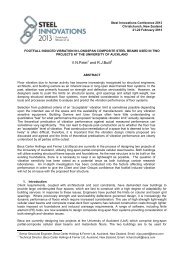Environmental Impacts of Multi-Storey Buildings Using Different ...
Environmental Impacts of Multi-Storey Buildings Using Different ...
Environmental Impacts of Multi-Storey Buildings Using Different ...
You also want an ePaper? Increase the reach of your titles
YUMPU automatically turns print PDFs into web optimized ePapers that Google loves.
Timber Plus ProjectTimber TreatmentThe following methods <strong>of</strong> timber preservative are listed in order <strong>of</strong> preference. These preferences should befollowed according to the level <strong>of</strong> protection required by the New Zealand Building Code and NZS3602.1. Use <strong>of</strong> plantation timber which does not require treatment. The most reliable way to avoid decay isto use good quality well seasoned timbers in locations which are well protected from the elements,have good ventilation and can be readily inspected. Rot producing fungi are able to form when nontreatedtimber is subject to moist conditions for a prolonged period <strong>of</strong> time. (Including duringconstruction). Selection <strong>of</strong> timber species with high natural durability increases timber life. (Refer tothe following section for further information on natural durability ratings).2. Boron Salts for H1 hazard ratings in all locations which are protected from the weather. Borontreated timber is not deemed hazardous.3. CAF - Copper-based, chrome and arsenic-free treatments (such as Alkaline Copper Quaternary -ACQ) where the Building Code requires H3.2 and H5 hazard ratings. Note that certain metalproducts (including fasteners, hardware and flashing) may corrode when in direct contact with woodtreated with copper-based preservatives. To prevent premature corrosion and failure it is important t<strong>of</strong>ollow the recommendations <strong>of</strong> the manufacturers for all metal products. CAF treated wood should beregarded as toxic waste when disposed <strong>of</strong> and should not be burnt or mulched.4. LOSP - Light organic solvent preservatives where the Building Code requires H3.1 treatment. Notethat there is an increase in VOC emissions when LOSPs are applied.5. The use <strong>of</strong> CCA - (copper chrome arsenic treatments) is to be avoided. Arsenic is a knownCarcinogen and, when absorbed into the human body significantly increases the incidence <strong>of</strong> somecancers. Arsenic can be absorbed through the skin, ingested or inhaled. In the case <strong>of</strong> CCA timbertreatments people are most at risk where there is repeated hand contact combined with hand tomouth contact. For this reason CCA treated timber is not recommended for applications such aschildren’s play equipment, work surfaces etc. In the United States and in several European countriesthere are restrictions / bans in place for CCA treated projects. Although the risk is widely regarded asminimal alternatives which are Arsenic free are preferred. CCA treated wood is regarded as toxicwaste when disposed <strong>of</strong> and should not be mulched or burned.Timber Durability ClassesWithin New Zealand there are four durability classes. These are based on field tests <strong>of</strong> identically sizedheartwood stakes with ratings as follows:-Natural DurabilityHeartwood Service Life (Years)Class Fully Protected Above Ground (Exposed) In GroundD1 50+ 50+ 25+D2 50+ 30 15 – 25D3 50+ 15 8 – 15D4 50+ 8 < 5Timbers incorporated into the design <strong>of</strong> the Timber Plus building have the following natural durability ratings:-Pinus Radiata - Non-Durable D4Thuja Plicata - Durable D2Picea Abies - Non-Durable D4Page 3 <strong>of</strong> 21 May 2008
















